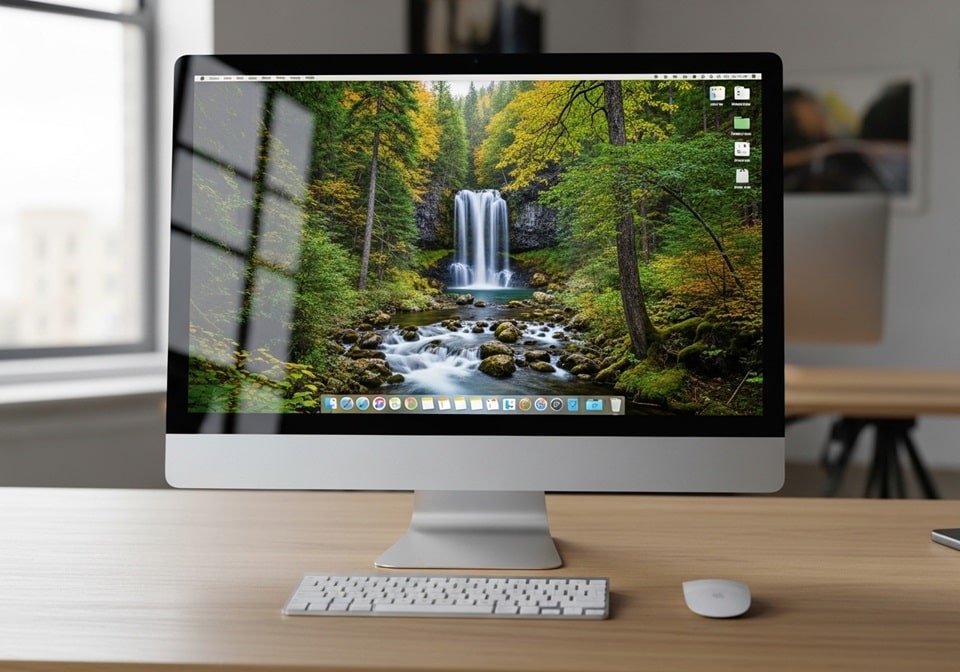
Understanding Why iMac Lacks Touch Screen Technology Despite User Demand
The question of whether Apple’s iMac computers feature touchscreen displays remains one of the most frequently asked queries among consumers considering Mac purchases. Despite the prevalence of touchscreen technology across competing desktop and laptop computers from Microsoft, HP, Dell, Lenovo, and other manufacturers, Apple has steadfastly maintained its position against implementing touch-enabled displays on any Mac computer, including the iMac, MacBook Air, and MacBook Pro. This decision stems from deeply rooted design philosophy principles that have guided Apple’s approach to human-computer interaction since the company’s founding, yet recent developments suggest this long-standing position may be evolving as the company reportedly develops touchscreen Mac prototypes for potential release in the coming years.
Understanding Apple’s resistance to touchscreen Mac computers requires examining the company’s Human Interface Guidelines, ergonomic research into vertical touchscreen fatigue, the strategic product differentiation between iPad and Mac lines, and the technical challenges associated with adapting macOS for touch input without compromising the precision and efficiency that define the Mac user experience. As of November 2024, no iMac model includes touchscreen functionality in its standard configuration, though third-party external touchscreen monitors can theoretically connect to Mac computers with specialized software. This comprehensive analysis explores Apple’s design rationale, the historical context of touchscreen decisions, competitive landscape dynamics, and what the future may hold for touch-enabled Mac computers.
Current iMac Models and Touch Capability Status
Apple’s current iMac lineup consists of the 24-inch iMac featuring the M3 or M4 chip, introduced with a complete redesign in 2021 that brought vivid color options, a thinner profile, and improved display technology. The iMac M3, released in 2023, delivers exceptional performance with its Apple Silicon architecture, featuring a stunning 4.5K Retina display with over 11.3 million pixels, 500 nits of brightness, support for one billion colors, and True Tone technology that automatically adjusts color temperature based on ambient lighting. Despite these impressive display specifications that would seemingly benefit from touch interaction, none of these features include touchscreen capabilities whatsoever.
The 24-inch iMac display measures 23.5 inches diagonally with a 4480-by-2520 resolution at 218 pixels per inch. The screen incorporates anti-reflective coating and supports the P3 wide color gamut, making it ideal for creative professionals working with photography, video editing, and graphic design. Users interact with the iMac exclusively through traditional input methods including the Magic Keyboard, Magic Mouse or Magic Trackpad, and external pointing devices. The absence of touch functionality represents a deliberate design choice rather than a technical limitation, as Apple possesses extensive touchscreen expertise demonstrated through iPhone, iPad, and Apple Watch products.
For users who require touchscreen functionality with Mac computers, workarounds exist but involve significant compromises. Third-party manufacturers produce external touchscreen monitors that can connect to Mac computers via HDMI or USB-C connections. Companies like ViewSonic manufacture touchscreen displays, such as the TD2455 model, that work with Mac computers when paired with specialized software like vTouch for Mac. However, these solutions provide limited functionality because macOS fundamentally lacks optimization for touch input, meaning users cannot seamlessly tap, swipe, or pinch-to-zoom as they would on touchscreen-native operating systems like Windows or iPadOS.
Steve Jobs and the Gorilla Arm Syndrome Explanation
The foundational reasoning behind Apple’s rejection of touchscreen Mac computers traces directly to comments made by company co-founder Steve Jobs during an October 2010 MacBook Pro event. Addressing circulating rumors about potential touchscreen MacBook development, Jobs categorically dismissed the concept with memorable and emphatic language that has shaped Apple’s approach ever since. He stated that Apple had conducted extensive user testing on touchscreen laptop concepts and concluded definitively that the technology does not work effectively for computers with vertical displays. Jobs explained that while touchscreen demonstrations appear impressive initially, users quickly experience fatigue from holding arms extended toward vertical screens.
Jobs introduced the concept that human-computer interaction researchers term gorilla arm syndrome, describing the physical discomfort and muscular fatigue that results from prolonged use of vertically oriented touchscreens. He articulated that after short usage periods, users begin experiencing arm fatigue, and after extended sessions, arms feel ready to fall off entirely. Jobs declared the experience ergonomically terrible, arguing that touch surfaces want to be horizontal rather than vertical, which explains why tablets work effectively with touch input while laptops and desktop computers do not. He emphasized that Apple had perfected multitouch trackpad technology specifically because it represented the optimal method for bringing multitouch capabilities to notebook computers without ergonomic compromises.
The gorilla arm phenomenon represents a well-documented issue in human-computer interaction research dating back to the 1980s when touchscreens first emerged commercially. The New Hacker’s Dictionary defines gorilla arm as the fatigue experienced when making small, precise movements with arms extended, noting that designers of early touch-menu systems failed to recognize that humans are not physiologically designed to hold arms in front of faces making small motions for extended periods. This ergonomic reality influenced Apple’s product strategy, reinforcing the company’s conviction that touch input works optimally for handheld devices held at comfortable angles rather than vertical displays requiring extended arm positions.
Apple’s Human Interface Guidelines and Design Philosophy
Apple’s approach to input methods stems from the company’s comprehensive Human Interface Guidelines, documentation that has guided software and hardware design since 1977 when the original guidelines were created for the Apple II computer. These guidelines represent far more than simple technical specifications, embodying Apple’s fundamental philosophy about how humans should interact with technology. The HIG emphasizes principles including wayfinding, feedback, consistency, proximity, mapping, and direct manipulation, all designed to create intuitive interfaces that feel natural to users without requiring extensive learning curves or explicit instruction.
The company deliberately uses the term human interface rather than the more common user interface terminology, reflecting a philosophical commitment to designing for complete human beings with imperfections, limitations, and diverse capabilities rather than treating people as mere system operators. This human-centered approach influences every design decision, from physical hardware ergonomics to software interaction patterns. Apple’s guidelines explicitly distinguish between direct manipulation, where users interact directly with interface elements as with touchscreens on iOS devices, and indirect manipulation, where users employ intermediary input devices like mice, trackpads, or keyboards to control on-screen elements as with Mac computers.
The distinction between touch-first and pointer-first interfaces represents a core tenet of Apple’s product differentiation strategy. iPads are optimized as touch-first devices where fingers directly manipulate content through taps, swipes, and gestures, with keyboard and mouse support added as optional enhancements. Conversely, Macs are optimized for indirect input through precise pointing devices that enable pixel-perfect cursor control, making them ideal for tasks requiring precision such as photo editing, detailed design work, and complex software development. Apple marketing executive Tom Boger explained in a 2024 interview that the company views iPad and Mac as complementary rather than competing devices, each optimized for its primary interaction paradigm.
The iPad Pro Alternative and Product Line Strategy
Apple’s resistance to implementing touchscreens on Mac computers connects intimately with the company’s broader product portfolio strategy, particularly the positioning of iPad Pro models as premium touch-enabled computing devices. When questioned about why Mac computers lack touchscreens, Apple executives consistently point to iPad as the company’s touch-optimized computer, featuring hardware and software specifically designed from inception to excel with touch input. This positioning creates clear product differentiation that helps consumers understand which device best suits their needs while avoiding direct cannibalization between product lines that might occur if Macs gained touchscreen capabilities.
The iPad Pro lineup features powerful M-series chips identical to those powering Mac computers, with the latest models incorporating M4 processors that deliver laptop-class performance in tablet form factors. These devices feature stunning displays including the 11-inch and 13-inch Liquid Retina XDR screens with tandem OLED technology offering exceptional brightness, contrast, and color accuracy. iPad Pro models support the Apple Pencil Pro for precision stylus input, enabling detailed illustration, note-taking, and creative work that would be impractical with finger-only touch. The Magic Keyboard accessory transforms iPad Pro into a laptop-like device with integrated trackpad, creating a hybrid computing experience.
Apple has marketed iPad Pro with the tagline “Your next computer is not a computer,” positioning it as a potential Mac replacement for certain users and use cases. However, this positioning faces challenges as iPad Pro devices command prices rivaling entry-level MacBook models while running iPadOS rather than macOS, limiting software compatibility and professional application availability. Critics note that despite iPad Pro’s impressive hardware capabilities, iPadOS imposes limitations including restricted multitasking, limited external monitor support compared to Macs, and inability to run certain professional applications that require macOS. This creates frustration among users wanting touchscreen computing with full desktop operating system capabilities.
Recent Patents and Touchscreen Development Rumors
Despite Apple’s public statements opposing touchscreen Macs, patent filings and industry reports suggest the company may be reconsidering its position or at least exploring touch-enabled Mac concepts for potential future products. In 2023, Apple filed patent applications describing iMac designs with pivoting stands that could tilt displays to various angles, drawings that bear striking resemblance to Microsoft’s Surface Studio, a touchscreen all-in-one computer designed for creative professionals. While Apple stated the patent focused on improving transportability and space efficiency, the designs suggest potential accommodation for touch interaction, particularly if displays can tilt to more horizontal orientations that reduce gorilla arm fatigue concerns.
Bloomberg journalist Mark Gurman, known for accurate Apple product predictions, reported in January 2023 that Apple was actively developing MacBook Pro models with touchscreen displays targeting release as early as 2025. According to Gurman’s sources, these touchscreen MacBook Pro models would retain traditional laptop designs with standard keyboards and trackpads, adding touchscreen functionality as a supplementary input method rather than replacing existing controls. The devices would reportedly feature OLED display technology using tandem OLED panels similar to those in iPad Pro, offering improved contrast, deeper blacks, and better power efficiency compared to current LCD displays.
In October 2025, Gurman provided updated information indicating that Apple’s first touchscreen MacBook Pro models equipped with M6 chips might enter production in late 2026 or early 2027. These devices would feature lighter, thinner designs than current models, abandon the display notch in favor of hole-punch cutouts similar to iPhone’s Dynamic Island, and include OLED screens with touch support. Gurman noted the devices would cost several hundred dollars more than current MacBook Pro models due to pricier components. Significantly, Gurman indicated Apple was not actively developing additional touchscreen Mac models beyond MacBook Pro, suggesting the company would assess customer reception before expanding touch capabilities to MacBook Air, iMac, or other Mac products.
Historical Touchscreen Mac Attempts and Modifications
Contrary to widespread belief that touchscreen Macs never existed, modified touchscreen iMac G3 computers actually reached the market over two decades ago through Apple’s Value Added Reseller program. In 1999, companies including Elo TouchSystems produced touchscreen versions of the iconic translucent iMac G3 for customer service kiosk applications, retail point-of-sale systems, and educational institutions. These modified iMacs used innovative surface acoustic wave technology with transducers transmitting and receiving waves to determine touch locations, avoiding overlays that would degrade display quality while enabling pressure-sensitive touch years before iPhone’s 3D Touch.
The touchscreen iMac G3 modifications addressed practical needs in specific environments where traditional mouse input proved impractical or unhygienic. Customer service kiosks in retail stores, restaurants, hospitals, and public spaces benefited from touch interfaces that eliminated vulnerable mechanical components susceptible to damage or contamination. The iMac G3’s infamous hockey puck mouse design made it particularly unsuitable for public kiosk applications, while touchscreens offered intuitive interaction for users unfamiliar with computer interfaces. However, these niche modifications never received Apple’s direct endorsement or integration into mainstream consumer products.
Few touchscreen iMac G3 units survived to present day, making them curiosities for vintage technology collectors. YouTube videos exploring these rare devices demonstrate the technical sophistication of the acoustic touch technology while highlighting how far ahead of mainstream adoption the concept was. The existence of these modified Macs proves Apple long possessed technical capability to implement touchscreens but chose not to for philosophical rather than purely technical reasons. The company’s decision to permit Value Added Resellers to create touchscreen versions for specialized applications while refusing to bring touch to mainstream consumer Macs underscores the deliberate nature of Apple’s input method choices.
Competitive Landscape and Windows Touchscreen Adoption
Apple’s resistance to touchscreen computers stands in stark contrast to the broader computer industry where touchscreen laptops and all-in-one desktops have become commonplace options across Windows and ChromeOS devices. Microsoft’s Windows 8 operating system, released in 2012, was designed explicitly around touchscreen interaction, featuring a touch-first interface that prioritized large, finger-friendly tiles and gestures. While Windows 8’s radical departure from traditional desktop paradigms proved controversial and faced significant user backlash, it established touchscreen support as a core Windows feature that persisted through subsequent Windows 10 and Windows 11 releases.
Today, touchscreen Windows laptops span all price segments from budget Chromebooks to premium ultrabooks and gaming machines. Manufacturers including HP, Dell, Lenovo, Microsoft, Asus, and others offer 2-in-1 convertible designs with 360-degree hinges allowing devices to transform between traditional laptop and tablet modes. These convertibles address gorilla arm concerns by enabling users to fold screens flat or tent laptops at comfortable angles for touch interaction. Microsoft’s Surface lineup exemplifies successful touch integration, with Surface Pro tablets, Surface Laptop convertibles, and the artist-focused Surface Studio desktop all featuring touch-enabled displays with optional Surface Pen stylus support.
The Surface Studio deserves particular attention as it directly addresses ergonomic objections Apple raised against touchscreen desktops. Microsoft’s all-in-one computer features a Zero Gravity hinge enabling the large 28-inch display to tilt from vertical to nearly horizontal positions, creating a digital drafting table perfect for artists, designers, and other creative professionals. In this configuration, users can draw directly on the screen using the Surface Pen without experiencing arm fatigue, as displays rest at comfortable angles similar to traditional drafting boards. The Surface Studio proves that with appropriate mechanical design, touchscreen desktops can deliver compelling experiences for specific workflows, though the device’s niche positioning and premium pricing limit mainstream appeal.
The Gorilla Arm Debate and Real-World Usage Patterns
While Steve Jobs’s gorilla arm argument resonated strongly when articulated in 2010 and influenced industry discourse for years afterward, subsequent experience with touchscreen laptops suggests the phenomenon may be less problematic than Apple predicted. Millions of Windows users have lived with touchscreen laptops for over a decade without widespread complaints about debilitating arm fatigue. Technology journalists and users who initially shared Apple’s skepticism, including those who purchased touchscreen Windows devices expecting to validate Jobs’s warnings, often report being pleasantly surprised by practical usability and finding that occasional touch interactions prove genuinely useful without causing significant discomfort.
The key insight critics of gorilla arm concerns emphasize is that nobody uses touchscreen laptops exclusively with extended arms and forefingers as Jobs seemed to envision. Instead, users employ touchscreens as supplementary input methods alongside traditional keyboards, mice, and trackpads. Touch proves most valuable for specific gestures including scrolling through long documents or web pages, pinching to zoom images, tapping occasional links or buttons, and navigating photo galleries. These interactions typically involve brief arm extensions rather than sustained vertical reaching, minimizing fatigue. The keyboard and mouse remain primary input methods for extended work sessions requiring precision or text entry, with touch serving as a convenience feature rather than replacement.
Intel executives acknowledged this complementary usage pattern, describing touchscreen laptops as offering an additional input medium designed to complement keyboards and trackpads rather than replace them. Users report that after initial novelty wears off, they may interact with laptop touchscreens relatively infrequently, but when touch proves convenient for specific tasks, they appreciate having the option available. Some users note accidentally brushing laptop screens occasionally, finding these unintended touch inputs annoying, while others struggle to remember their laptops even support touch after years of ingrained keyboard-and-mouse habits. The mixed usage patterns suggest touch on laptops serves a supporting rather than transformative role.
macOS Design Challenges for Touch Implementation
Beyond ergonomic concerns, implementing touchscreen support on Mac computers faces significant software design challenges as macOS was architected from inception for precise pointer input rather than finger-based touch. The entire operating system interface features UI elements sized and spaced for cursor accuracy rather than finger accessibility. Buttons, checkboxes, sliders, and other interactive controls throughout macOS measure only a few pixels across in many cases, making them frustratingly small targets for average-sized fingers. Menu bar items, dock icons, toolbar buttons, and disclosure triangles all assume pixel-perfect pointing precision enabled by mice and trackpads but impractical with fingertips.
Windows faced similar challenges when Microsoft attempted to retrofit touch support onto a pointer-designed operating system, resulting in awkward compromises where interfaces oscillate between touch-optimized and mouse-optimized paradigms. Touch-friendly controls with generous hit targets and spacing look oversized and wasteful on desktop displays operated primarily via mouse, while mouse-optimized interfaces with compact controls prove tedious to operate via touch. Microsoft’s solution involved creating separate touch and desktop interface modes, but this dual-paradigm approach confused users and required developers to design interfaces twice. Apple would likely resist such compromises, preferring to maintain macOS’s coherent pointer-based design rather than introducing inconsistency.
The arrival of Apple Silicon and ability to run iOS and iPadOS applications natively on Mac computers paradoxically highlights the absence of touchscreens while simultaneously demonstrating potential benefits. Mac users can now install iOS apps including popular games designed for touch control, but must operate them using mouse cursor emulation rather than natural touch gestures. Playing touch-based puzzle games, casual titles, or interactive storybooks with a mouse feels unnatural and cumbersome compared to direct touch interaction on iPad. This creates frustration among users who recognize that many iOS apps would work wonderfully on iMac’s large display if only the screen supported touch input as it does on iPad.
Technical Considerations and Trade-Offs
Implementing touchscreen technology on iMac computers involves multiple technical considerations beyond software compatibility, including display engineering trade-offs, power consumption implications, thickness and weight impacts, and cost increases. Touchscreen displays require additional digitizer layers between the LCD or OLED panel and outer glass surface to detect finger position through capacitive or other sensing technologies. These extra layers can affect display quality by introducing additional air gaps that reduce contrast, create internal reflections, or slightly diminish brightness. Display manufacturers work to minimize these effects, but touch-enabled screens still face inherent quality disadvantages compared to non-touch displays when controlling for other variables.
Power consumption represents another consideration as touchscreen digitizers require continuous electrical power to scan for touch input. While modern touch controllers operate efficiently, they still contribute measurably to overall system power draw. This proves less significant for desktop iMac computers with constant wall power but creates meaningful implications for potential touchscreen MacBook models where battery life represents a critical specification. Apple traditionally prioritizes maximum battery runtime in portable devices, making the company potentially reluctant to sacrifice even modest battery capacity for touch features many users might rarely utilize in practice.
Manufacturing costs increase with touchscreen implementation as the digitizer components, lamination processes, and additional quality control testing add expenses that would translate to higher retail prices for consumers. For MacBook Pro laptops already commanding premium prices, adding several hundred dollars for touchscreen functionality might price devices beyond many potential customers’ budgets. Apple must weigh whether enough customers value touch input sufficiently to justify cost premiums and whether the company can maintain its target profit margins while remaining price-competitive. Industry reports suggest Apple’s planned touchscreen MacBook Pro models would indeed cost several hundred dollars more than current non-touch versions.
Future Outlook and Potential Product Scenarios
Multiple possible scenarios exist for how Apple might introduce touchscreen technology to Mac computers if the company proceeds with reported development plans. The most likely initial implementation involves touchscreen MacBook Pro models as Bloomberg reports suggest, positioning touch as a premium feature for professional users willing to pay higher prices. This approach would allow Apple to test market reception, gather real-world usage data, and refine macOS touch interactions before potentially expanding touch capabilities to other Mac products. If touchscreen MacBook Pro models succeed commercially and demonstrate meaningful user value, Apple might subsequently bring touch to MacBook Air, iMac, Mac mini with external touch displays, and eventually the entire Mac lineup.
Alternatively, Apple might create entirely new product categories blending characteristics of iPad and Mac rather than simply adding touchscreens to existing Mac designs. Reports mention Apple exploring products that cross foldable iPad with touchscreen Mac, potentially creating large-screen foldable devices that function as both oversized iPads and Mac computers depending on configuration. Such products might run macOS with extensive touch optimization when used in tablet mode while switching to traditional pointer-centric interfaces when used with external keyboards. This approach could justify dramatic industrial design changes that address ergonomic concerns Jobs raised about vertical touchscreens.
Another possibility involves Apple maintaining its current position indefinitely, with reported touchscreen Mac development ultimately abandoned or shelved following internal testing that validates original gorilla arm concerns. Companies regularly prototype products that never reach market after discovering insurmountable user experience issues, technological limitations, or insufficient market demand. Apple’s reputed touchscreen Mac prototypes might prove disappointing in practice despite impressive demos, leading the company to conclude that Jobs’s original assessment remains correct even with modern display technology. In this scenario, iPad and Mac would continue as distinct product lines with clear differentiation between touch-first and pointer-first paradigms.
Conclusion
The question of whether iMac features touchscreen capabilities receives a definitive negative answer as of November 2024, with no current or past mainstream iMac models incorporating touch-enabled displays. This absence reflects deliberate design philosophy stemming from Apple’s conviction that vertical touchscreens create ergonomic problems including gorilla arm fatigue, that macOS optimizes for precise pointer input rather than finger-based touch, and that iPad products already serve customers seeking Apple devices with touchscreen capabilities. Steve Jobs’s 2010 statements rejecting touchscreen laptops as ergonomically terrible have shaped Apple’s approach for over a decade, establishing clear product differentiation between touch-first iPads and pointer-first Macs.
However, compelling evidence suggests Apple may be reconsidering this long-standing position as the company reportedly develops touchscreen MacBook Pro prototypes potentially releasing in 2026 or 2027. Patent filings showing iMac designs with adjustable stands reminiscent of Microsoft Surface Studio, combined with credible reports from industry insiders, indicate that Apple at minimum is seriously exploring how touch could enhance Mac computing without compromising the precision and efficiency that define the Mac experience. Whether these explorations result in shipping products or remain internal experiments only time will reveal.
For consumers currently considering iMac purchases and hoping for touchscreen functionality, the reality is straightforward: no native touchscreen iMac exists today, workarounds using external touch monitors provide severely limited functionality, and if Apple does introduce touch-enabled Macs, MacBook Pro laptops will likely receive the feature before desktop iMac computers. Users requiring touchscreen computing with Apple hardware should strongly consider iPad Pro models, particularly 12.9-inch or 13-inch variants with Magic Keyboard accessories that approximate laptop functionality. The future may bring touchscreen Macs that vindicate those who have called for the technology for years, or it may prove Jobs’s original ergonomic concerns remain as valid today as when first articulated, making the pointer-based Mac and touch-based iPad permanent fixtures of Apple’s product strategy.











